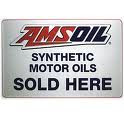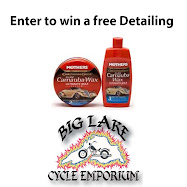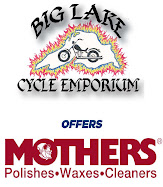Do you have any question's about your motorcycle? if so just shoot me an e-mail or give me a call with your question... Advice is all way's FREE at Big Lake Cycle! 715-718-2277
CLICK HERE to Ask Will a Question
CLICK HERE to Ask Will a Question
Engine, Transmission, Chain
How often do I need to change the oil? - There are several schools of thought on this. Some say you should change your oil every 3000 miles; others say every 6000 miles is fine. In any case, you should change it every 3 months using conventional oil every 6 month's using a quality Synthetic.
Should I use petroleum-based oil or synthetic oil? - We recommend and install AMSOIL Synthetic Motorcyle Oil and here is why..... A NEW - Motorcycle Oil whitepaper study. Tests performed by Southwest Research show 15 top rated 40W and 50W motorcycle oils head to head in 12 critical tests including Viscosity Sheer Stability, Foam Control, Gear Performance, Price and High Temperature/High Sheer Viscosity. Sever top brands fail out of grade even before the end of a typical testing cycle.
They certainly didn't think anyone would spend the $200,000 it takes to run these tests so you could see where they rank in quality. AMSOIL says "You can clearly see we are not the best in every test but when you consider our performance across the board conclusively and where it counts, we offer the consumer unmatched quality." Click Here Now to see how your oil stacks up Download the Motorcycle Oil Study - (1MB PDF File)
How often do I need to lubricate the chain? What with?
Every 600 miles or 1000 km, either spray wax chain lubricant or pour some gear oil on it. Big Lake Cycle Recommends and Stocks...
AMSOIL Heavy Duty Metal Protector is the product of choice for metal surfaces that require a heavy duty lubricant or are exposed to the damaging effects of salt, moisture or chemical corrosion. It is ideal for hinges, wire ropes and springs, nuts and bolts, motorcycle or bicycle chains, and for undercoating wheel wells and other metal surfaces exposed to water, dirt or road salt.
Performance Features
•Protects against rust & corrosion, even in salt water
•Displaces water
•Stops squeaks
•Lubricates metal surfaces
•Leaves a dry, long-lasting, wax like film
•Lubricant does not attract dust
•Does not sling off
•Sprays into hard-to-reach places
•Ideal for chains & other heavy-use items
How often do I need to check the chain’s tension? How?
Every 600 miles or 1000 km. Your motorcycle’s Owner’s Manual will have directions. If you do not have a manual just give Will a call and he will be happy to talk you through it.
With most motorcycles, you check the tension with the bike on its side stand. I found that with most bikes up on a motorcycle lift, I could get the tension right. The key is to have the suspension at the correct sag.
You need to check the tension at several points along the chain’s travel around the engine and wheel sprockets. The tension should be set so that the loosest spot and the tightest spot are still within the slack tolerance specified in the owner’s manual. If the tightest spot is at the tightest allowed and the loosest is beyond the tolerance, then it’s time to get a new chain and sprocket set.
Do I have to replace the sprockets at the same time I replace the chain?
Yes. It’s likely that the sprockets are worn. Putting a new chain non a worn pair of sprockets will make the chain wear out faster—and replacing the sprockets without replacing the chain will sear out the sprockets. Do them as a set.
Fuel System, Exhaust
This is the most important thing, dispose of untreated gas older than 6 months rather than risk running it. Check your fuel line for damages due to weather or cracks etc. If you find any damages even minor replace it. Next thing is to check your fuel filter, make sure it is not clogged and looks clean and clear. If it is older then a year then it is better to replace it. Remember to turnoff the fuel tap when parking your motorcycle for longer duration, this prevents fuel from leaking out.
Make sure you regularly check and keep your oil level at its HIGH or MAX level. It is best to check your oil level on the bikes centre stand or when it is in a level position. An under filled oil level can be disastrous while too much oil over the limit may flood your air cleaner with oil. Regular oil and filter changes will keep your bike young and healthy.
What grade (octane rating) of fuel should I use and why?
Use the minimum octane that does not cause your engine to knock. Anything more is wasted money. If you have a older bike built in the 80's I would recommend 93 +
Do I need to turn the fuel valve off to park the bike overnight or longer? Does it do any harm to leave it on?
If the float valve is in good shape and everything else is OK, no, you don’t have to turn off the fuel petcock. However, if anything isn’t perfect you’ll have, at best, gas all over the bike and the floor. At worst, you’ll fill one cylinder with gas and the other cylinder will fire when you try to start it and you’ll go into hydro lock and bend a connecting rod. Do you feel lucky?
What does it mean to “re-jet” the carburetors?
Carburetors supply a mixture of gasoline and air to the engine. The gas comes out of little things called “jets” (usually a pilot jet, needle jet and main jet). If you modify your airbox or exhaust to flow more freely, you get more air going through your system. This often means that there is not enough gasoline, so the engine runs badly. “Rejetting” means replacing or modifying some of these jets so as to supply gasoline differently than stock, usually more gasoline than stock. If done correctly, this allows your engine to generate more power, run a little cooler, start and run smoother and get worse mileage.
Tires, Suspension, Steering
How do I break-in my tires?
If you take aggressive turns on new tires, you may dump your bike. New tires may have sticky or slimy goo on them, either mold-release compound from the manufacturer to make sure the tire comes out of the mold, or lubricant to let the tire slip more easily onto the rim. (Tire manufacturers and installers deny that such materials exist.) In any case, new tires are smooth and have limited traction. Take turns gently, slowly increasing your angle of lean. Slowly is the key: You always want enough of the contact patch to be on the broken-in section that you don’t lose it. Eventually your chicken-strips will disappear.
What’s the difference between radial tires and bias-ply tires?
The main difference between radials and bias-ply tires lies in their construction. Tires aren’t just toroidal balloons, they are reinforced with cords of steel or synthetic materials such as nylon or Aramid. In bias-ply tires, the fibers are wrapped in an X pattern between the beads; in radial tires, the fibers are wrapped perpendicular to the tread. Radial tires have more flexible sidewalls than bias-ply tires, and thus absorb road irregularities better and have a comparatively larger contact patch when leaned over. Because of the flexible nature of a radial, these offer higher mileage compared with a comparable bias-ply for a given rubber compound. Since they absorb small road irregularities better, they ride more comfortably and are less likely to be upset by groovy pavement.
While radial tires perform better than bias tires, some older motorcycles can’t be fitted with radial tires because of differences in rim profiles. You probably won’t notice much of a difference anyway, so stick with boas tires if that’s what the motorcycle was designed for.
Why can’t I mix radials and bias tires?
The different ways in which radial and bias tires react to sideways loads can lead to unpredictable behavior while cornering. It’s bad enough to do this on a four-wheeler, but it can be even worse on a motorcycle. If you need to replace one tire and the same type is not available, then go ahead and replace both tires with the same type.
Electrical System
I want to add auxiliary lights. Does my alternator have enough extra capacity to do this?
Maybe. The new BMW oil heads definitely do, but sport bikes tend to have alternators big enough just to run the existing electrical devices and charge the battery. Best thing to do is call me and we will figure it out.
Can I use mineral water to put in the battery?
No! Those minerals will break the battery. It has to be distilled water.
Brakes
Really important not just for your ride but also for your safety. Change the brake fluids every year and your brakes will perform at their best. While changing brake fluids use only sealed one as brake fluids tends to absorb moisture. Also check the thickness of the brake pads and if it looks thin replace it. Otherwise if it goes down to metal, your brake disc may get damaged & ultimately result in unnecessary replacement fitting braided steel brake lines will also boost the performance of your brakes.
Or just ask Will









